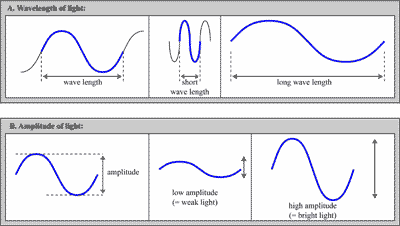A. What is Light?
1. Light is a radiation. It starts at a source (the sun or a lamp) and radiates at enormous speed (about 300,000 km/sec), from that source, in a straight line. |
2. Light consists of photons; these are very small packets of energy (smaller than electrons).
|
3. The photons travel as WAVES or ‘wiggles’. These waves can be very fast (short wavelength) or very long (long wavelength). |
4. It is important to note that these photons travel though vacuum; they don’t need a medium for their transportation (unlike sound propagation). |
5. The wavelengths can be very very short such as X-rays and gamma rays (1 nanometer (=nm) meter or less (nm = nanometer = 10-9 m = 0.000000000001). |
6. The wavelength can also be quite long, such as radio waves; typically several meters long. |
7. Our eyes are only sensitive to a small range (or spectrum) of light; from 400 to 700 nm. We see the short wavelength (at about 400 nm) as violet/dark blue, while the longer wavelength (approximately 700 nm) is seen as red. All colours are determined by their wavelengths within the visible range. |
8. The amplitude of the light wave determines the brightness of light. A high amplitude is a very bright light. A low amplitude makes the light dimmer. |
9. Note that the color of the light is determined by the wavelength, not by its amplitude. A red light can be very bright (= high amplitude) or very soft (= low amplitude). |
|






